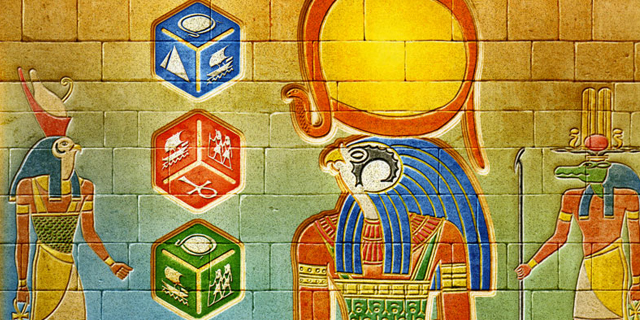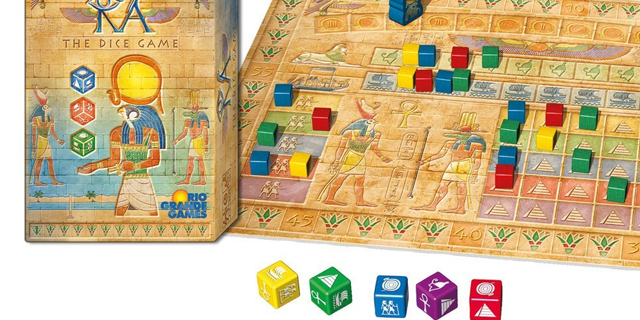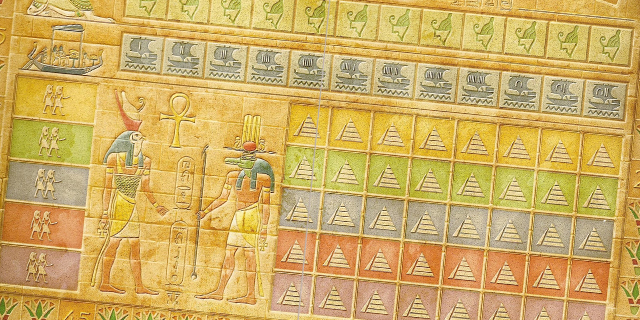
I’ve discussed Reiner Knizia’s Ra before (twice, actually), and it remains both one of the premier tile-based auction games available and a great “gateway” game to modern boardgaming. Auctions are a main mechanic in that game, but you score points via set collection, and there is no small element of “press your luck” when it comes to drawing tiles out of the bag hoping to avoid the dreaded final Ra tile. As it turns out, “press your luck” and set collection don’t only work with tile-based games, as Knizia was also able to substitute square cardboard for plastic cubes with his 2009 spin-off title Ra: the Dice Game.
Like most dice games, Ra Dice uses the Yahtzee standard of giving each player five dice, three rolls and the option to keep or re-roll (almost) any of the dice each time. The sides of the five different-colored custom dice in Ra Dice represent Suns, Pharaohs, Rivers, Monuments, Civilizations and Ankhs, most of which correlate directly to their equivalents in the non-dice version.
Pharaohs and Rivers are mostly straightforward, as each instance rolled will advance your marker on the respective track one space (to a maximum of 12), although if you roll three Rivers, you can instead use them to “flood” your track — which is the only way you can actually score points for the Rivers you have accumulated, so you should probably do that as soon as possible each round (flood status resets after scoring). At the end of each round, the player with the most Pharaohs scores five points, and whoever has the fewest loses two points; since Pharaohs do not reset each round, the tracks are instead adjusted after scoring, with the leader losing two spaces and and the fewest being increased by one.

Civilizations are crucial but tricky. You need to roll at least three of them to claim one space, and you are restricted to claiming one of the colors you have rolled. Additional Civilizations on top of the three let you claim additional spaces, but there is a limit to how many players can claim a given space. Not having claimed any Civilizations will cost you five points at the end of any given round, while claiming three or more will earn five, ten, or even 15 should you be lucky enough to get all five colors. As with the original game, Civilizations reset each round.
Monuments can be claimed by rolling at least one, but it takes two additional results for each extra you want. Color is important here as well, as you can only claim Monuments of colors you have rolled, and an additional restriction of one space per column of the Monument track is in place should you claim more than one per turn. This is because claiming three or more spaces in the same column will earn you big points at the end of the game (as with the original game, Monuments do not score each round). Monument points can also be earned for each column in which you have claimed a space, with bonus points should you claim in seven or even all eight of them.
Ankhs are wild and can supplement any other non-Sun result. But you cannot use the Ankh’s color when determining viable Civilization or Monument spaces, so plan accordingly. By themselves, a pair of Ankhs can also be scored for two points. Suns cannot be rerolled, and depending on the ultimate number rolled will either advance the round-ending Ra track one or two spaces, award three points or cause all of the roller’s opponents to suffer a Disaster in an area of your choice. This will cost them two spaces of their choice (or their flood status if they have it and you choose to punish everyone’s River track). The game ends when the Ra track is filled for the third time.

Anyone familiar with traditional Ra will see the similarities between the two games, but there is one important difference: speed. Simply put, Ra Dice is a blisteringly-fast game once everyone knows what combinations allow you to claim spaces, which is greatly assisted by the included player aids. Without the extra work of drawing tiles from a bag, choosing whether or not to invoke Ra and agonizing over what to bid while trying to predict what value your opponents place on the current lot, a session of Ra Dice can usually be played in well under half an hour, which is amazing. Ra Dice mostly restricts its main decisions around what dice to keep and how to score your final result. This is rarely complicated but not devoid of its own strategic choices.
Of course, being a dice-oriented game carries its own drawbacks as well. The most prominent of these is that the number of Suns isn’t a fixed (and in many ways inevitable) quantity like it is with a bag of tiles, and thus the frequency at which they appear (or not) will dramatically affect the ultimate length of the game.
Still, as dice games go, Ra: the Dice Game is among the very best. I’ve never felt cheated by poor rolls or crushed by exceptionally lucky ones, as just about any result can claim you one or more spaces. Whether or not those spaces will result in enough points to win is what makes the game fun. The ability to largely choose your re-rolls gives you some degree of control over your strategy, and the rest is up to the whims of the gods.
Ra: the Dice Game retails for around $30 and supports up to four players.



















